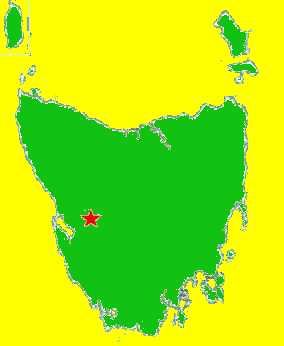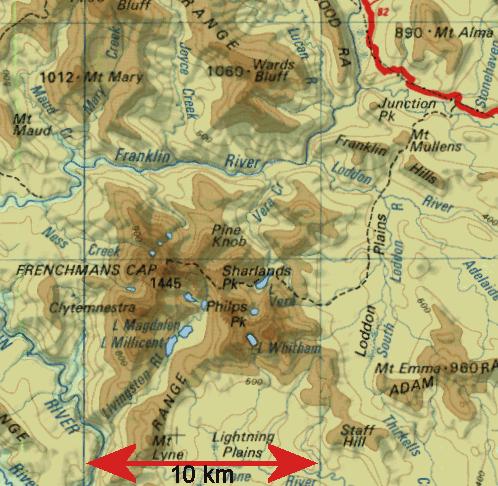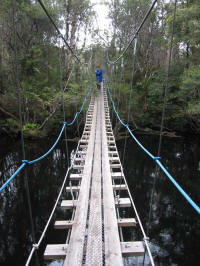

FRENCHMANS CAP - Western Tasmania©
MATTHEW WATTON AND TONY WATTON
11/12/2003 - 14/12/2003


Day 1 - Thursday 11/12/2003
After a slowish start from Hobart – as Matthew worked night-shift until about 8.00am – we did a bit of last-minute shopping (warm gloves for Matthew, milk powder, salad rolls for lunch) and got under way.
The car trip from Hobart to to the start of the walk on the Lyell Hwy was uneventful, apart from a 10-15 minute nap on the Fourteen Mile Road. This is a forestry road that is a short cut that bypasses the valley where the Tarraleah Power Station is located. Matthew dozed off from time to time and obviously needed the rest.
When we arrived at the start of the walk there was no car space available where we wanted to park. However, after a short time some people who had been just walking 100m or so up the track returned and left so we parked Matthew’s car in their spot.
At 2.15pm we started the walk and after about 1 hour met 3 people (1 male and 2 females) who had walked out from Lake Vera Hut that day. They said the track was dry, which encouraged us a lot because the track across Loddon Plains is notoriously muddy - where you can easily sink up to your waist in mud.
After climbing the shoulder around Mt Mu llens we descended
to the Loddon River and were pleasantly surprised to find that, although the
track was spongy, it was by no means boggy – a very easy track.
llens we descended
to the Loddon River and were pleasantly surprised to find that, although the
track was spongy, it was by no means boggy – a very easy track.
We talked about where we should stay that night, and saw on the map 2 possible campsites on the Loddon Plains. If it rained heavily while we stayed there overnight we might have had to plod through thick bog for the rest of the walk over the plains. We decided to keep going to Lake Vera Hut for a comfortable night and hoped the hut wasn’t full.
After leaving the plains we had a steep climb through forest before an equally steep, but short descent to the hut. The composting toilet appeared about 100m before (and above) the hut – nice welcome for the walkers. We reached the hut at about 8.15pm (6 hour stroll from the highway to the first hut).
There were 8 other people at the hut, already most having had their dinner and were playing cards. There were 2 men from South Australia, 2 older German men, 2 young German men, 1 German woman and 1 English woman who was travelling with the younger Germans. (We didn't mention the war!)
They made us welcome and when we had changed and unpacked our sleeping bags, we cooked a packet pasta with sour cream and chives, chilli salmon and cashew nuts. Very tasty if slightly unusual. We washed it down with a cup of hot chocolate.
While the others were still playing cards we climbed into our sleeping bags for an early night (about 9.30pm). We were pleased with our day’s work.
Day 2 - Friday 12/12/2003
We were up at about 7.15am while the others were getting themselves ready for the walk out to the car park. We were the only 2 going on to Frenchmans Cap. Breakfast consisted of a muesli bar and hot chocolate. We then packed our gear up and headed off on the next leg. We planned to go only as far as Lake Tahune Hut (at about 1,000m still a fair climb from 500m or so at Lake Vera). After spending the night at Lake Tahune we intended tackling the final 400m climb on Saturday morning, then walk back to Lake Vera Hut if the weather was bad or further to a campsite if it was fine.
Today’s walk was in reasonable weather but much cloud prevented us from seeing any views of local peaks. There was a very steep climb up to Barron Pass but the track work that has been done by Parks and Wildlife is really amazing – first rate steps, benching and carved tree trunks up and down extra steep sections.
Arriving at Lake Tahune Hut we found we were the only occupants of the hut and we soon became very cold. We read the log book, had lunch and started to listen to the cricket (2nd Test against India in Adelaide). After 2 hot chocolate drinks we had to get into our sleeping bags it was so cold. We slept from about 2.30pm to 7.00pm. We then got up and cooked our evening meal – macaroni cheese with tuna and cashew nuts (unusual again - but still tasty!)
Frenchmans Cap was completely obliterated by cloud and there was heavy rain. Later in the evening we were lucky enough to get a clear view of the stunning Cap and took a couple of awe-inspiring photos.
We kept reading the track notes we had brought about climbing the peak, trying to anticipate the route before we actually got there. This seldom works - but what else can you do while you eagerly await the next leg.
We discussed our alternatives – if the cloud completely covers the top then we won’t even attempt it. I don’t think either of us seriously considered this because we had read the notes about the good track and did not want to be disappointed. The more realistic alternative was to start up regardless of conditions and check out what was happening further up the mountain. We knew that conditions can change very quickly and it's impossible to forecast a couple of hours ahead.
If we were to go the plan was to leave our big packs at Lake Tahune Hut and take only light packs with water, muesli bars, waterproof gear, GPS, compass, map, EPIRB and cameras.
We were tucked up in our sleeping bags and asleep again by about 8.30pm.
Day 3 - Saturday 13/12/2003
Matthew’s phone alarm woke us at 5.50am and he listened to the weather forecast (closest was for Strahan). My radio apparently respected the wilderness’s serenity and did not want to work for me that day.
The forecast was for NW to W winds at about 40kts with rain and thunderstorms on the West Coast. We hoped it would miss us.
A cup of hot chocolate with a very hard muesli bar (almost frozen) for breakfast and we decided that, even though the Cap was obscured due to cloud, rain, and later snow, we would give it a try and see how far we reached towards the summit.
We packed our light day packs using 2 of Matthew’s sea kayak dry bags as inners and roughly packed our large packs, to be left in the hut awaiting our return.
7.30am saw us starting up the well-constructed steep track, with good visibility in the immediate area (50m visibility) but zero to any of the surrounding peaks. At one point we took a false “track” by not following a poorly painted arrow correctly at the junction of the Irenabyss track. It had been well trodden by other previous walkers. At this sign we should have climbed up the rock face behind the sign but instead we went left and would have ended up with a 70m cliff to negotiate.
The problem with the arrow was that the arrow had a long base and short sides pointing up and so it is different from all the other direction arrows that have a short base and long sides to point to the correct route - which was an inconsistency with the other markings on the track.
After our short detour - wasting about 10 minutes - we reached the top at about 8.50am but we could have been anywhere – no sign of anything except the barren top, each other, the trig point, and fields of snow. It was blowing very hard. We took a couple of photos and left the top after only 5 minutes. We could have walked to the edge of the cliff without ever knowing we were there (until the freefall). On the way down it started to hail and settle underfoot, making progress a bit more tentative. By the time we had got back to Tahune Hut it had turned to heavy rain. As we were climbing down Matthew wondered what the closed track would have been like. It seemed to go straight up a gully from the first steep ascent and would probably have cut off a lot of distance for Irenabyss walkers. This route is closed for rehabilitation. With the erosion from walkers this gully would turn into a creek and eventually a waterfall.
Back in the hut – no visitors - freezing cold. It was 9.50am. We made a hot drink and re-packed our main packs. We were getting very cold with our wet outer clothes as our bodies cooled inside them. We started out again at about 11.00am. Matthew couldn’t feel his hands for the next 30 minutes of our walk and then they ached as the circulation started to come back.
There were very strong wind gusts wherever we were on exposed parts of the track, especially near Barron Pass. However, these were not as bad as on our crossing of the Ironbounds (South Coast Track - Nov 2002) where we were blown off our feet at regular intervals.
The rest of the trip back to Lake Vera Hut was uneventful, except for light rain falling continuously. Creeks and waterfalls were flowing well and there was some water on parts of the track, which was mainly rock-based.
Lake Vera Hut was a welcome sight at 2.30pm. We were a bit surprised to find we were the only visitors. No more arrived that night either.
Dinner was a packet curried chicken and pasta, salmon with chilli and cashew nuts. This was an early meal and we had cleaned up by about 7.00pm and relaxed at the lower altitude with another hot chocolate.
I was feeling pretty tired, having climbed up and down Frenchmans Cap then from Tahune Hut to Lake Vera Hut so decided to have an early night. I think Matthew stayed up a bit longer. I remember saying something like: “If I fall asleep soon I hope you have a good night sleep.” Apparently I did fall asleep soon after that and Matthew alleged that within 5 minutes I was snoring away. I suppose it’s true.
Day 4 - Sunday 14/12/2003
We awoke as usual at 5.50am to the sound of Matthew’s phone alarm going off and I started a hot drink while Matthew began to pack.
It had been something of a luxury to have had the hut to ourselves (20 person capacity) and we had made the most of it by spreading our wet gear around in the hope that it would dry overnight. It only got cold and was still damp.
This hut has a pot-belly stove installed but the drawback is that the temperature inside the hut needs to be below 10oC before the occupants are “allowed” to use it.
We thought the thermometer was rigged to always read 14oC. Also, it was placed very near to where all the cooking was done!
We tidied up the hut a bit – Matthew swept it out and so ended a very enjoyable, if short, stay.
On the track again at 7.30am and immediately we were faced with an uphill climb past the toilet. A hill at the start of the day is always a bit unpleasant first thing on a walk, even though we had stretched beforehand.
As it had been raining steadily overnight (and much of Saturday as well) we talked about what lay ahead on the Loddon Plains. Would the rain on the surrounding hills have flooded them or was the bog hard enough to absorb a lot of water before becoming sodden? Not that we could do anything about it anyway. We would find out soon enough.
We were overawed by the beauty of the sub-alpine plants. Matthew said it reminded him of a miniature botanical garden laid out around us. As we made our way down towards the Loddon Plains we were surrounded by delicate fragrances of the various wildflowers.
Once again we were very impressed with the track-work before and after the Loddon Plains. A lot of excellent work has been done that helped to make progress considerably easier for us than it would otherwise have been.
Whilst there was some bog on the Loddons – Matthew in particular found one patch up to his thighs that did not want him to escape – overall the track was still firm enough not to have to detour too much from the main route.
Some sections of bog heaved and strained as we crossed them. It was as if there was a thin crust of solid mud (barely) covering a heaving mass of liquid mud beneath it - like a thin crust on the top of a dormant volcano ... I guess!
As we crossed the suspension bridge over the Loddon River we said "hello" to three 40-something (aged) men who were on Day 1 of their trip. One of them had a pack he said weighed 28kgs. (By comparison ours weighed about 19 – 20kgs each). I offered to help him out by taking some of his gear but he explained that he had 3 ice cream containers of vegetables with him and didn’t really want to leave anything. They looked horrified at the state of our gaiters and the mud up our thighs as they didn't have gaiters. We wished them the best of luck and plodded on.
The walk in from the car park to Lake Vera Hut had taken us 6 hours on Thursday. Therefore, we reckoned that, having left Vera Hut at 7.30am, we might get back to the car park (and hopefully still have a fully operational car!) by about 1.30pm.
After an exhausting climb over the shoulder of Mt Mullens and a couple of rest breaks for refuelling we eventually made it back to the intact car at 12.40pm. Although our trip was spread over 4 days, the elapsed time from and to the car park was actually less than 3 days (by about 2 hours). I felt happy about that.
Even though we did not see anything from the top of Frenchmans Cap the trip was well worth the effort. Maybe we will return in what might be better weather conditions to actually experience the grandeur of the views from the top.
We had a well-deserved salad roll and drink at the service station at Derwent Bridge. Matthew bought 2 postcards of Frenchmans Cap and explained to the assistant that, even though we had climbed it, we had not seen it.
Thanks to Matthew for being enjoyable company and for his patience at my slow progress, both up and down the hills.